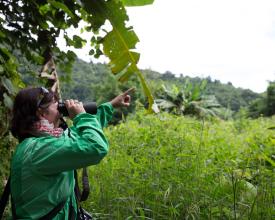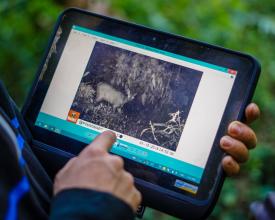Wildlife Conservation Ecotourism in Nam Et-Phou Louey National Park, Lao PDR

The Nam Et-Phou Louey National Park (NEPL NP) is one of the largest and most biodiverse protected areas in Laos. At the same time, more than 30,000 people from 91 village, representing multiple ethnic groups located within some of the poorest districts of the country, are living inside or immediately adjacent to the NEPL NP.
To provide livelihood opportunities for local people and to safeguard the national park’s wildlife biodiversity and ecosystems on which communities rely on, the NEPL NP begun wildlife ecotourism program in 2010.
The NEPL NP ecotours have been designed in a way to create a direct link between conservation and tourism so that the money generated by visitors acts as an incentive for the local communities working in tourism and living around the ecotourism area to protect wildlife. This is achieved through both direct employment in the ecotourism service provider groups, and through a wider financial incentive system to the surrounding communities based on their conservation efforts.
Context
Challenges addressed
The NEPL NP is affronting numerous threats and challenges. The main direct drivers of habitat loss and poaching in NEPL NP are:
- Unsustainable and/or illegal timber extraction,
- Unsustainable and/or illegal infrastructure development (roads, hydropower, mining and etc),
- Local and regional demand for bush meat and rare animal parts, and
- High poverty.
These threats paired with the continuous pressure of economic growth further increases the weight on wildlife and the natural habitat of NEPL NP.
Location
Process
Summary of the process
The NEPL NP’s (1) “Ecotourism Benefit Fund” agreement with the communities surrounding the ecotourism area is the key pillar to create a direct link between ecotourism and wildlife conservation. The (2) “Ecotourism service provider contracts” ensure transparency and equity in the ecotourism service provider selection process and tourism revenue distribution in the village. The (3) “Local Capacity Building and Awareness Raising” is essential to develop a strong team in long-term and ensure support by the decision makers and public. Regardless, (4) “Law Enforcement” presence is essential in wildlife tourism areas, as simply developing wildlife tourism does not automatically lead to a reduction of threats or improved levels of wildlife protection. To ensure increasing visitor arrivals, (5) “Marketing and collaboration with tourism private sector” is essential for tourism products located in remote areas. Finally, (6) “Monitoring and Adaptive Management” is indispensable to ensure the project's sustainability and positive conservation and socio-economic outcomes.
Building Blocks
Ecotourism Benefit Fund
To create a wide community support for conservation, the Ecotourism Benefit Fund (EBF) was introduced by NEPL NP. Through the EBF, the NEPL NP not only delivers to the villages surrounding the ecotourism area a fixed amount of money for every tourist going on the tour, but an additional amount is provided depending on the numbers and type of wildlife encountered by the visitors on the tour. To encourage conservation efforts, greater incentives are provided for sightings of species with higher conservation importance.
While the NEPL NP ecotourism program provides direct tourism revenue opportunities to members from only around 40% of households in 4 village, in total 26 villages receive financial benefits annually from the NEPL NP tourism program based on their conservation efforts.
Enabling factors
- Ecotourism Benefit Fund (EBF) Agreement,
- Annual Ecotourism outreach meetings with all participating villages,
- Financial incentives based on the community conservation efforts,
- Conservation objectives linked with financial incentives for the communities.
Lesson learned
- The link between community conservation efforts and tourism revenue must be clear and direct, – simply improving villager incomes may not lead to improved conservation, however, reducing poverty is an essential step towards improved natural resource utilization and conservation efforts over the long-term.
- In addition to the positive incentives for conservation in the EBF strategy design, the benefit distribution agreement should also outline disincentives for breaking the regulations. For example, if anyone from the ecotourism villages is caught violating the agreement, then the yearly EBF of the respective individual’s village is reduced.
- To ensure equity in the EBF sharing, the EBF is calculated and distributed yearly to all ecotourism villages based on the number of households and the EBF is used to support small-scale village development activities chosen by each village by a popular vote, rather than distributing cash payments.
Ecotourism service provider contracts
An inclusive, fair and transparent participation process and tourism benefit sharing mechanisms are key to building and maintaining trust within local communities.
In order to spread the tourism benefits fairly in the village, it is important to set clear and fair regulations for the ecotourism service provider selection. In case of NEPL NP ecotourism program, the key elements are:
- 1 person per household. Only one member from each household is allowed to have membership in only one service group,
- Poor and disadvantaged families are prioritized in the selection process,
- No NEPL NP regulation violation for min. of the 2 years.
To ensure transparent and equitable ecotourism service provider selection process, a multi stakeholder committee votes for the voluntary candidates. The committee consists of the following members: (1) village ecotourism head, (2) existing ecotourism service providers and (3) the national park staff who work closely with the communities.
Enabling factors
- Ecotourism Service Provider Contracts
- Transparent and Equitable selection process
- Strict contract implementation
- Participative and Transparent contract amendment process
Lesson learned
The ecotourism service provider work and regulations must be clearly presented to the community and there must be an opportunity for questions/answers, and negotiation. Overtime amendments may occur and must be again only confirmed once approved by the community.
Capacity Building and Awareness Raising
The NEPL NP ecotourism program directly and indirectly creates skills and capacity building opportunities and awareness raising for the following groups: (1) NEPL NP ecotourism team itself (2) Ecotourism communities and service providers (3) Visitors, TOs and the government counterparts.
When NEPL NP program began in 2010, tourism was almost non-existing in the region. By offering an opportunity to learn to the locals and recruiting tourism consultants to support, the NEPL NP ecotourism staff now has grown into some of the most experienced ecotourism professionals in the country. Most of these staff come from the NEPL NP villages and are from a former hunter households or even used to be hunters themselves. By working with the NEPL NP, staff have learned about the importance of conservation and today are well acknowledged ecotourism officers and conservation advocates. Some of the NEPL NP’s ecotourism staff have raised up to key NEPL NP management and advisory positions.
The NEPL NP ecotourism team now creates and coordinates ecotourism training opportunities and outreach campaigns. In addition, NEPL NP ecotourism program has a non-negligible awareness raising power that benefits all visitors as well as TOs and the government counterparts.
Enabling factors
- Trainings, Workshops, and Study Tours
- Close collaboration with key decision makers
Lesson learned
- Close collaboration with local community and government agencies throughout the development and management of the projects is essential.
- During the ecotourism program beginning, recruiting qualified local human resources was challenging, therefore, staff from other provinces were selected. However, due to the NEPL NP’s remote location, these staff moved away after short period of time. Recruiting less qualified, but local and motivated staff and providing the necessary skills and capacity building opportunities have presented greater results and higher level of commitment.
Law Enforcement
Two ranger stations are located in the two NEPL NP ecotourism sites. The law enforcement teams in the ecotourism area apprehend illegal activities, protect the tourism infrastructures and contribute data to the Ecotourism Benefit Fund calculation. In addition, the NEPL NP ecotours deliver benefits to the NEPL NP law enforcement program through the following activities: (1) regular presence in NEPL NP, (2) illegal activity identification (3) communication on the protected area's regulations to communities & visitors
Enabling factors
- Mobile ranger teams
- Law enforcement strategy, financial and human resources
- Prosecution
Lesson learned
- An active law enforcement presence is essential in wildlife tourism areas, whereas simply developing wildlife tourism does not automatically lead to a reduction of threats or improved levels of wildlife protection.
- Due to limited financial and human resources, the law enforcement presence might lack to be equally distributed within all the ecotourism area. It may therefore be necessary to incorporate additional monitoring mechanisms that can be equally assessed, for example monitoring community efforts in regards of the land encroachment by comparing the land use plan and the satellite images.
Marketing and Collaboration with tourism private sector
The NEPL NP is located in one of the most remote parts of the country, far away from the key tourism hubs and airports. To attract visitors to this remote part of the country, clear marketing, excellent reputation and collaboration with the TOs and Travel Agents are essential.
Enabling factors
- Close collaboration with the private sector (TOs, Travel Agents, Hotels etc),
- Updated, attractive and comprehensive marketing resources,
- Media exposure,
- Awards.
Lesson learned
- Close collaboration with TOs and Travel Agents is essential when located in a remote part of the country. In addition to organizing transportation arrangements to the visitors, the TOs and Travel Agents can also trigger fantastic marketing and international visibility opportunities to the destination.
- Former clients are the excellent marketing agents, especially for the domestic tourism.
- Awards and Positive international exposure enhance good collaboration with government counterparts.
Resources
Monitoring and Adaptive Management
Regular monitoring of the NEPL NP’s ecotourism program is essential to ensure the conservation objectives as well as continuous visitor satisfaction and therefore the overall project sustainability. The NEPL NP ecotourism program monitors the following information:
- Wildlife monitoring is adapted to the ecotourism area and incorporates all or some of the following techniques: Camera trapping, GPS recorded all direct/indirect observations, Species recording of direct observations.
- Financial data is entered in the system for every tour and is analysed on monthly and annual basis
- Visitor Feedback data is collected from all visitors after every tour and allows to identify and improve tour services at the best delay as well as offers an opportunity to consider new ideas and further improvement needs.
- Visitor Arrival and Profile is collected from all visitors on every tour and allows to identify the visitor trends and profile and therefore better understand and communicate to the market, as well as identify new opportunities.
Enabling factors
- Data collection forms
- Wildlife Monitoring systems (direct observations, camera trapping, etc)
- SMART (Spatial Monitoring and Reporting Tool)
Lesson learned
- The data collection systems must be simple to use and straight forward,
- The collected ecotourism data can be useful for the National Park management, especially the wildlife data and law enforcement observations.
Impacts
- Wildlife Conservation: Significant conservation benefits through a decrease in threats and a measurable increase in wildlife sightings. The average wildlife sightings on the Nam Nern Night Safari wildlife spotting tour have increased from 4 animals only in 2010 to 11 animals in average per tour in 2021.
- Livelihoods: Additional livelihood opportunities for more than 150 households in 4 villages. 40% of the ecotourism service providers are women and 30% are younger than 30 years old.
- Wide benefit sharing. 26 villages representing more than 2’000 households receive financial incentives based on the seen wildlife by visitors on the NEPL NP ecotours, - representing almost 30% of all NEPL NP villages, and mostly Khmu and Hmong ethnic minority groups. In addition, the NEPL NP ecotourism program generates financial benefits for the National Park, tourism entrepreneurs and government.
- Education: Continuous educational and skill development opportunities to multiple stakeholder groups (communities, visitors, government) as well as a positive education environment for NEPL NP ecotourism staff.
- Positive International Exposure: Through various awards and visibility in the leading media, the NEPL NP ecotourism program creates positive international exposure to the country.
Beneficiaries
- More than 150 ecotourism service provider households,
- 26 communities around NEPL NP ecotourism sites,
- Nam Et-Phou Louey National Park,
- Government,
- Entrepreneurs (hotels, restaurants, shops, travel agents).
Sustainable Development Goals
Story

Traditionally wildlife is valuable to the NEPL NP communities, but only once the animal is captured or killed as then the animal can be sold to earn additional income for the household or can be consumed to feed the family. With the increasing domestic and regional demand for bush meat and rare animal parts and growing human population, this is no longer a sustainable practice.
To overcome this challenge, the NEPL NP introduced ecotourism as an alternative source of revenue to hunting. However, tourism, particularly in remote-low tourism areas, has its limitations as not all community members can be employed in tourism or in the related sectors.
To create a wide community support to conservation and to share the tourism revenue, the Ecotourism Benefit Fund (EBF) was introduced by NEPL NP. Though the EBF, the NEPL NP not only delivers to the villages surrounding the ecotourism area a fixed amount of money for every tourist going on the tour, but an additional amount is provided depending on the numbers and type of wildlife encountered by the visitors on the tour. To encourage conservation efforts, greater incentives are provided for sightings of species with higher conservation importance.
In the beginning, when NEPL NP began the ecotourism program in 2010, many ecotourism service providers attempted to enjoy both revenue opportunities: ecotourism and hunting. Consequently, the respective individuals received a warning or their contract was terminated, and their village’s annual EBF was reduced. This was a valuable lesson learned to others.
With increasing visitor arrivals, grew also the community revenue from ecotourism services and EBF. Consequently, more households became interested in ecotourism and were willing to comply with the national park regulations. The former household members who violated the regulations could re-apply for the ecotourism positions if their record was clean for more than 2 years. Now, 10 years later, more than 150 households in 4 villages work as ecotourism service providers (wildlife spotters, boatmen, cooks, souvenir producers, etc) and 26 surrounding villages receive financial benefits through the EBF, - this represents almost 30% of all NEPL NP villages.












